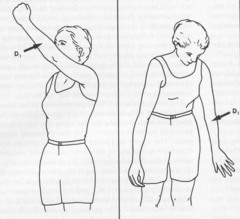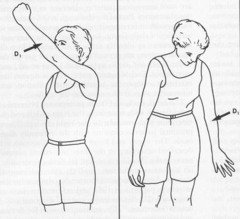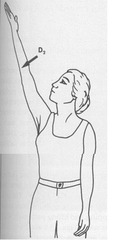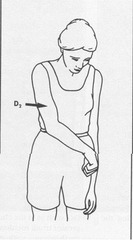PNF: Proprioceptive Neuromuscular Facilitation – Flashcards
Unlock all answers in this set
Unlock answersquestion
PNF: Diagonal patterns and facilitation techniques
answer
- the stronger muscles in the diagonal pattern facilitate the weaker ones - the brain knows nothing of the individual muscle actions - only movements ---------------------------------------------------------------- - when facilitating, incorporate all 3 planes of movement - start in lengthening range and end in shortened range
question
PNF
answer
- uses controlled sensory input - stronger muscles in diagonal patterns influence weaker ones - brain registers movement (not individual muscles) - PNF works with whole movement patterns to engage and improve motor output - a balance of antagonists are required - if an individual does not have this balance start with techniques that enhance the agonist movement
question
PNF theory
answer
- brain registers total movement - movements are spiral and diagonal - facilitation techniques are superimposed on these movement patterns - based on combination of cardinal planes of movement: flexion/extension, abduction/adduction, internal/external rotation
question
What is PNF? (quote)
answer
"A method of promoting or hastening the response of the neuromuscular mechanism through stimulation of the proprioceptors." - sensory stimulation is provided through manual contacts
question
PNF techniques are employed through patterns of movement using:
answer
-sensory stimulation - visual cues - verbal commands
question
History of PNF: Kabat
answer
- founder of PNF approach - neurophysiologist and physician - began work with poliomyelitis and MS - expanded to many disorders including orthopedic conditions - arthritis, peripheral nerve injuries, painful shoulders he found that when groups of muscles were stretched, they produce movement in diagonal patterns. This is the same for functional skills and in atheletes
question
History of PNF: theoretical background (Sherrington)
answer
1) Irradiation - facilitation of voluntary motion by another (when one m. fires, the other mm. fire) 2) successive induction - stronger antagonists facilitates a weaker agonist (ex: trying to move triceps, the biceps can be used) 3) reciprocal innervation
question
History of PNF: Theoretical background (Gesell)
answer
- motor behavior and patterned movements Gesell studied children and their writing habits: first random, then vertical, then horizontal, then circular, and finally diagonal: applied to gross movements. He also suggested that movements develop in the same way. First an infant moves with random movements of the arms and legs, then flexion and extension (vertical movements) followed by abduction and adduction(horizontal) and circumduction (circular) and lastly diagonal movements. It is of interest that diagonal movements which are the most complex are the first to be lost with neurophysiological disorders.
question
History of PNF: Hellebrandt
answer
- efficiency of movement (He found that certain combo of movements cn circumvent fatigue or speed recovery depending on the combination) - head movements affect arm and leg - studied TLR and ATNR
question
History of PNF: Pavlov
answer
- studied learning and habit development - Pavlov dogs - salivation
question
History of PNF: Margaret Knott
answer
- 1st physical therapist at the institution - worked alongside Kabat utilizing PNF approach - helped Kabat apply the techniques clinically
question
History of PNF: Dorothy Voss
answer
- worked with Knott (1952-54) - expanded theory by adding developmental total patterns -Voss helped develop theory and introduced the concept of total patterns and whole body movements
question
History of PNF: Voss and Knott
answer
Published first book in 1954 "Proprioceptive neuromuscular facilitation: patterns and techniques". Several editions have been published since 1954 Current edition is proprioceptive neuromuscular facilitation: patterns and techniques, 3rd ed., 1985. First course taught to OT's was in 1974 and continuing education courses are offered in PNF 1-2 week
question
Diagonal Patterns
answer
- When topographical aligned groups of muscles were stretched they produced movement in a diagonal pattern -Functional movements and sport skills revealed spiral and diagonal characteristics, highly skilled movements - The most successful combinations were those that permitted maximum elongation of related muscle groups so that the stretch reflex could be elicited through a "pattern". -a diagonal position of a limb put the group of muscles in their maximum elongation and this facilitated, through the stretch reflex, a diagonal movement in the opposite direction.
question
Evaluation with PNF
answer
1. Vital functions 2. Response to sensory cues 3. Head and neck patterns 4. Bilateral symmetrical to bilateral asymmetrical to bilateral reciprocal 5. Developmental postures 6. Functional taskS
question
Vital Functions
answer
Vital functions: respiration and breathing, swallowing, voice production, facial and tongue movements,
question
Sensory cues
answer
sensory (visual, auditory, and touch): what does the patient respond to
question
Proximal to distal
answer
head and neck, upper trunk, upper extremities, lower trunk, lower extremities especially look at head and neck patterns which are the key to upper trunk patterns and observe during developmental and functional activities.
question
Bilateral symmetrical to bilateral asymmetrical to bilateral reciprocal
answer
Movements develop in the following sequence and diagonal patterns return in the following sequence in patients with CNS disorders: evaluate where a patient is at during initial assessment and move the patient through the sequence in treatment Bilateral symmetrical, bilateral asymmetrical, bilateral reciprocal: influence of head, neck, and trunk postures, ROM, quality of movement: smoothness and rhythm, normal timing: coordinated
question
Developmental postures
answer
Developmental postures: supine, prone, sidelying, sitting, quadreped, kneeling, standing (example: a person may not exhibit shoulder flexion during isolated arm movements but when rolling may be able to perform this movement)
question
Treatment principles: 1
answer
All human beings have potentials not fully developed - Emphasis is on abilities to reduce inabilities, stronger movements strengthen weaker movements
question
Treatment principles: 2
answer
2.Normal movement follows a cervicocaudal and proximodistal direction -Attention is first given to the head, neck and then trunk and then extremities (particularly true for a patient with severe disability or a comatose patient), head and neck are involved in postural reflexes, influences reflexes and postural response, weight tends to shift to the side you are looking at
question
Treatment principles: 3
answer
3.Early motor behavior is dominated by reflex activity. Mature motor behavior is supported or reinforced by postural reflexes -Remember that reflex activity can be used to reinforce a movement, look to a certain side and create extension in the upper extremity using ATNR (integration of reflexes means they still are present in movement just not dominated by them)
question
Treatment principles: 4
answer
4.Early motor behavior is characterized by spontaneous movement, which oscillates between extremes of flexion and extension. Rhythmic and reversing in character. -Goal directed activity is made up of reversing movements 1 Standing up or sitting down 2 Dressing and undressing 3 Taking something out of the refrigerator 4 Zip and unzip 5 Writing (adduction and abduction 6 Turning something on and off
question
If patient is dominated by flexors facilitate extensors
answer
be careful in facilitating flexors too much (primitive response and may dominate) reciprocal patterns are goal
question
Treatment principles: 5
answer
5.Developing motor behavior is expressed in an orderly sequence of total patterns of movements and posture
question
Treatment principles: 6
answer
Normal movement and posture depend on "synergism" and a balanced interaction of antagonists
question
treatment principles: 7
answer
7.Normal motor development occurs in an orderly sequence but overlap does occur.
question
Sensory cues include
answer
-visual - auditory - tactile
question
Visual sensory cues
answer
- look in the direction of the movement - engage the person in the task with vision
question
Auditory sensory cue
answer
- verbal commands and tone of voice - Auditory: facilitate movement - tone of voice: soft voice if the goal is to reduce spasticity and slow down movement, loud to facilitate for weak muscles
question
Tactile sensory cue
answer
- patient feels the movement "I do - I understand" - touch helps guide and reinforce movement - May just need to touch lightly to assist a fatigued patient to complete a task. Remember guiding and key points of control from NDT
question
Facilitation techniques
answer
- practice, repetition - may break down the task into steps - goal directed techniques - to engage person in their environment - stress is needed for learning to take place - needs to be the right balance though
question
Movements are in harmony with topographica alignment of the....
answer
muscles from origin to insertion and spiral and rotary characteristics of skeletal systems of bones and joints
question
Diagonal Patterns - how are they made up, what is the major component, what are they combined with
answer
1. Each diagonal is made up of 2 patterns that are antagonistic to each other 2 flexion 2 extension * these refer to shoulder or hip (not the knee or elbow) 2. Each pattern has a major component of flexion or one of extension 3. the major components (flexion or extension) are always combined with two other components making a total of 3 components external or internal rotation abduction or adduction
question
proximal pivots
answer
shoulder and hip
question
Upper extremity: D1 flexion components

answer
flexion, adduction, external rotation But scapula is abducted, wrist is flexed, elbow can be flexed or extended, forearm is supinated, wrist flexed to radial side, fingers flexed
question
UE: DI extension components

answer
extension, abduction, internal rotation Scapula: adducted, depressed, rotated, elbow extended, forearm pronated, wrist extended to the ulnar side, fingers extended and abducted, thumb abducted
question
UE: D2 flexion components

answer
flexion, abduction, external rotation scapula is elevated, adducted and rotated Elbow flexed or extended, forearm supinated, wrist ext to radial side, finger ext and abducted, thumb extended
question
UE D2 extension components

answer
extension, adduction, internal rotation Scapula is depressed, abducted, and rotated, elbow flexed or extended, forearm is pronated, wrist is flexed to ulnar side and fingers flexed and adducted and thumb is in opposition
question
Supination of forearm and wrist to radial side consistent with....
answer
flexion and external rotation
question
Pronation of wrist to ulnar side consistent with...
answer
extension and internal rotation
question
Wrist flexion consistent with...
answer
shoulder adduction
question
wrist extension consistent with..
answer
shoulder abduction
question
Procedures
answer
1. Manual Contact 2. Stretch 3. Traction and approximation 4. Maximal resistance 5. Timing
question
Manual Contact
answer
open hand placed on patient - direction of pressure guides movement - location of hand can guide direction of movement
question
Stretch
answer
a quick stretch at end range - used to initiate voluntary movement - concentrate where needed - based on sherrington's principle of reciprocal inhibition Repeated stretch followed by assisted or voluntary motions can be effective technique in a patient with little or no voluntary control
question
Shortened range of a pattern/lengthened range
answer
Example: D2 extension is the shortened range of D2 flexion, you would give the quick stretch into D2 extension to facilitate D2 flexion
question
Traction and Approximation
answer
Traction: separating joint surfaces Approximation: compression of joint surfaces *both stimulate joint receptors
question
Maximal resistance
answer
optimal resistance that still allows your pt. to move *does not mean the most resistance you can provide but the optimal resistance that still allows your patient to move through the complete range of the movement Resistance combined with stretch as in repeated contractions may elicit irradiation for the purpose of using the motions of the stronger muscle groups to facilitate the weaker ones (or components)
question
irraditation
answer
contraction of stronger components facilitates contraction of weaker components
question
Timing
answer
Increase response and stimulating action at a specific pivot within a pattern (what is missing?)
question
Therapeutic application
answer
-All movements are reversing -Must have a balance of antagonists -If patient does not have this, first focus on techniques for the agonist -Need rotational component for PNF - it is not PNF if not rotational
question
Positions and Treatment
answer
Side-lying, prone on elbows, quadruped, plantigrade, kneeling, half-kneeling, long sit, short sit, tailor sitting, heel sitting, side sitting and chair sitting Modified plantigrade: standing or sitting with both arms in contact with a surface such as a table Start treatment in a position where the client is most stable Progression: basic mobility (ROM), stability, controlled mobility, skill
question
Progression
answer
Stability -Tonic holding -Co-contraction Controlled mobility: used once a patient demonstrates stability in a bilateral weight bearing position and isometric contractions in mid-range progress to one arm leaving contact with a stable surface, Simultaneous static dynamic (SSD) Consider the activity and the postural demands Can start in one posture, show progression, as patient fatigues return to less demanding posture
question
Tonic Holding v. Co-contraction
answer
Tonic holding is where the muscles can maintain an isometric contraction in their shortened range where muscles can maintain an isometric contraction in mid-range
question
Reflexes
answer
Reflexes support movement and underlie normal movement Use ATNR, optical righting reflex
question
Controlled Sensory Input
answer
Quick Stretch and Resistance Tactile Visual Stimuli
question
Quick Stretch
answer
Perform in lengthened range (use whole body)
question
Resistance: Goal
answer
Goal is irradiation to weaker synergistic muscles (overflow)
question
Tactile
answer
Where do you place manual contacts (MC)
question
Visual Stimuli
answer
Optical righting reflexes Head neck and trunk patterns
question
Basic Techniques
answer
First observe and decide which is the agonist movement and which is the antagonist Irradiation: weaker components of the movement are facilitated by the stronger muscle groups reciprocal inhibition: voluntary contraction of the muscle results in the antagonist relaxing Successive induction: the stronger antagonist becomes a source of proprioceptive facilitation for the weaker agonist- one action lowers the threshold for the other action



